How to Set Up Sensory Writing Trays with Salt or Sand (Trilingual)
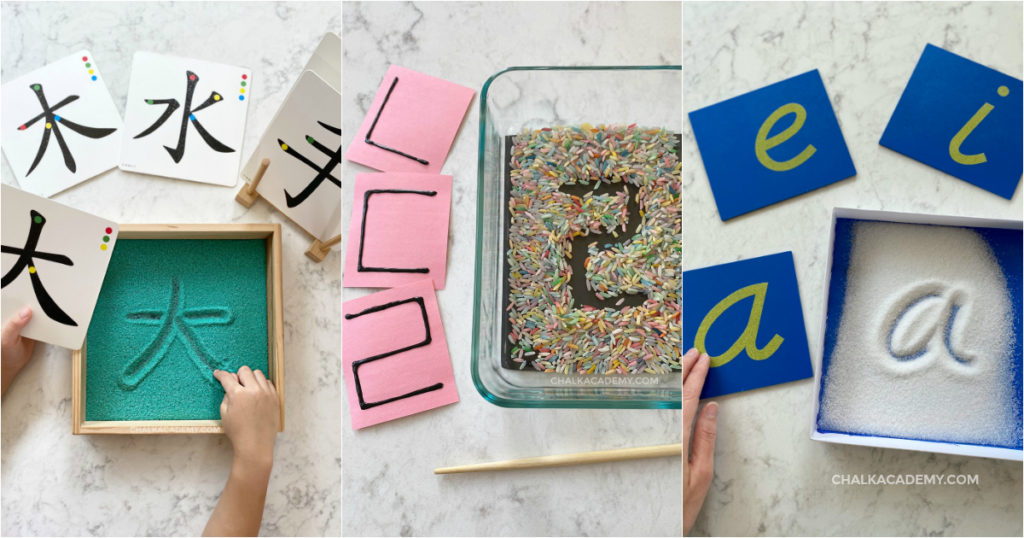
Have you ever noticed how children naturally like to run their hands through soft textures like sand and salt? Hands-on exploration is a crucial pre-writing activity! At home or in a classroom, you can set up a Montessori sensory salt writing tray. This sensory tray can help children develop writing skills in any language, such as Chinese, Korean, and English. In addition to Montessori salt writing trays, I’ll share tips and examples of sensory learning.
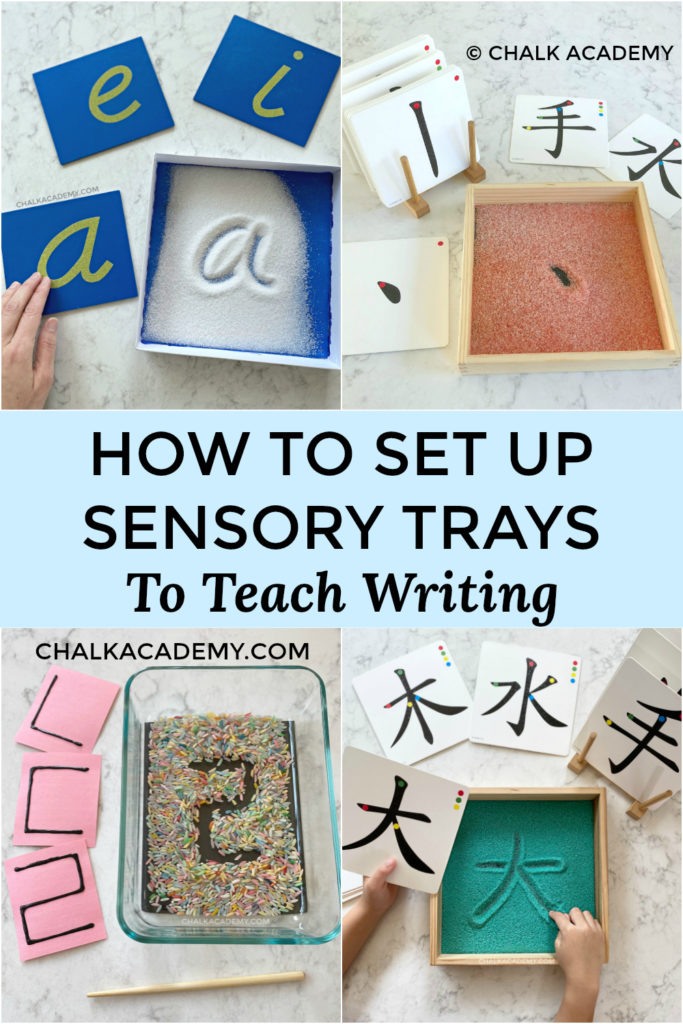
This article was originally written in August 2018 and has since been updated.
Chalk Academy is reader-supported. Some of the links are affiliate links. When you buy something through an affiliate link, we may earn a very small commission at no additional cost to you. More details here.
Is a sensory salt or sand writing tray necessary for teaching writing?
Many of us who grew up using traditional worksheets wonder if a salt writing tray is necessary. Every child is different; some children may enjoy a sensory writing tray while others might skip this activity.
Some Montessori classrooms have a sand writing tray for sensory writing practice in the primary years (ages 3-6). When my daughter was younger, she used the Montessori-inspired sensory writing tray to learn Chinese stroke order. However, she never used it for English or Korean, because she was comfortable using pencil on paper for these alphabets.
Other children might benefit from textured letters or characters, such as Puffy Paint Tactile Chinese and Korean Letters.
Related: When and How to Teach Chinese Characters to Kids?
Benefits of sensory salt or sand writing for children
For many children, the benefits of sensory writing with sand or salt include activation of the multiple senses:
- Tactile: Children love to touch and feel different textures, and the fingertip is the most sensitive part of the body. Each fingertip has thousands of touch receptors. When the receptors are stimulated by touch, neurons fire signals via nerves to the spinal cord, brain stem, thalamus, and finally the cerebral cortex for processing.
- Visual: Sensory writing trays allow kids to see how their fingers create letters and words.
- Auditory: As you will hear in the video at the end of the post, auditory stimulation provides synergistic input to help to commit each Chinese character to memory.
Multisensory experiences can help with memorizing Chinese characters and reading Korean and English phonetic sounds.
For children who are not yet ready to write alphabet letters or Chinese characters, they can practice drawing shapes in sand or salt!

Tips for using a Montessori salt or sand writing tray
- Children under age 3 years or those who are still mouthing non-food objects should refrain from this activity.
- Only a thin layer of salt or sand is needed, just a few millimeters. Otherwise, it could be hard to form letters and words in the sand.
- Use what you already have at home to save on cost. You don’t need to buy Montessori sand tray which sells for $15-$45!
What you need for a Montessori sensory writing tray
Container
Consider a square-shaped tray so your child get used to visualizing Chinese characters within the standard writing grid. High sides can help keep the sensory material within the tray. Here are a some ideas:
- Wood tray which can be repurposed from other toys like this and this.
- Box lid – can paint or put sheet of paper on the bottom for contrast
- Tupperware or baking dish
Soft granular material
- Sand
- Salt: can dye with few drops of food coloring in a zipper bag. Shake and mix thoroughly. Then air dry.
- Expired food: sugar, baking soda, polenta, ground oatmeal, rice, sprinkles
If kept clean and dry, salt, sugar, and sand can be reused. Remind your child to wash his or her hands before and after using the salt writing tray. Store in a sealed, labeled container.
Optional writing utensils
- Stick, chopstick, or paintbrush
Examples of Montessori sensory writing trays
White salt writing with a box lid tray
The easiest way to set up a Montessori sensory tray is with a thin layer of fine table salt and a box lid. Here’s an example of how it can be used with the Montessori English alphabet sandpaper boards. They are available in regular print, D’nealian font (pictured below), or cursive.
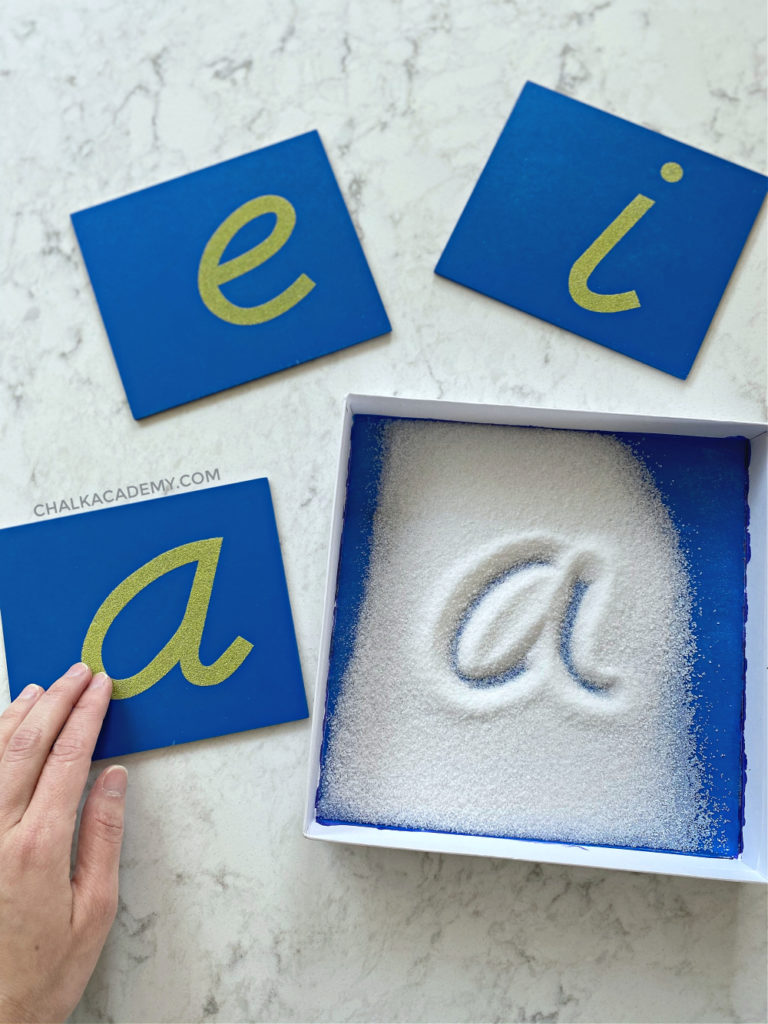
The below video from when my daughter was 3, trying the salt writing tray for the first time with our Uncle Goose Chinese Blocks! She insisted on writing with a stick and wanted to squish as many Chinese characters as possible into the little tray…
Notice that the paint at the bottom of the box is a bold color for contrast against the white salt. Contrast between the salt and the background allows for the written word to be more visible.
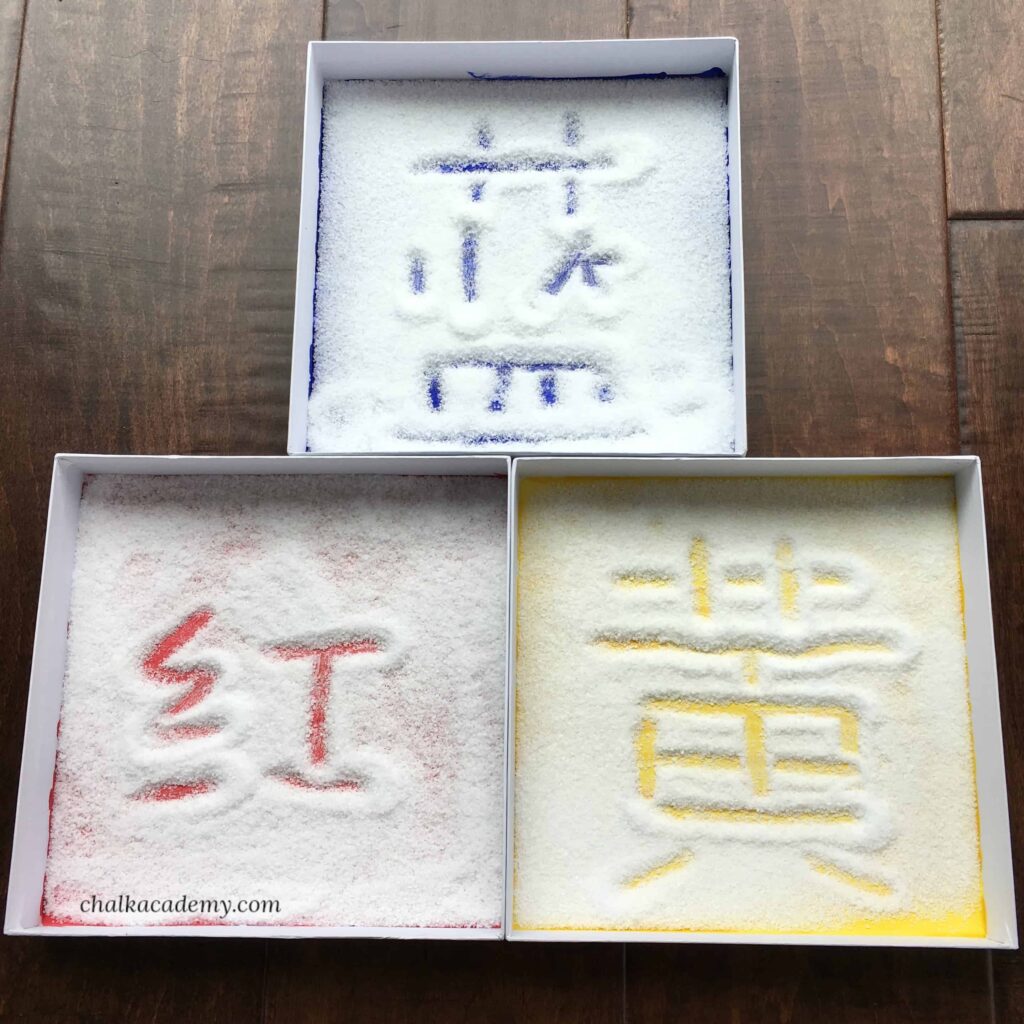
Colorful salt writing with tupperware tray
You can use a tupperware container as your sensory tray. We’ve also had fun dying salt into different colors. With just a few drops of red food coloring, we’ve created a pretty pale pink salt. But my kids prefer the calming turquoise blue! Here is that ocean blue salt with our Chinese stroke order flashcards!
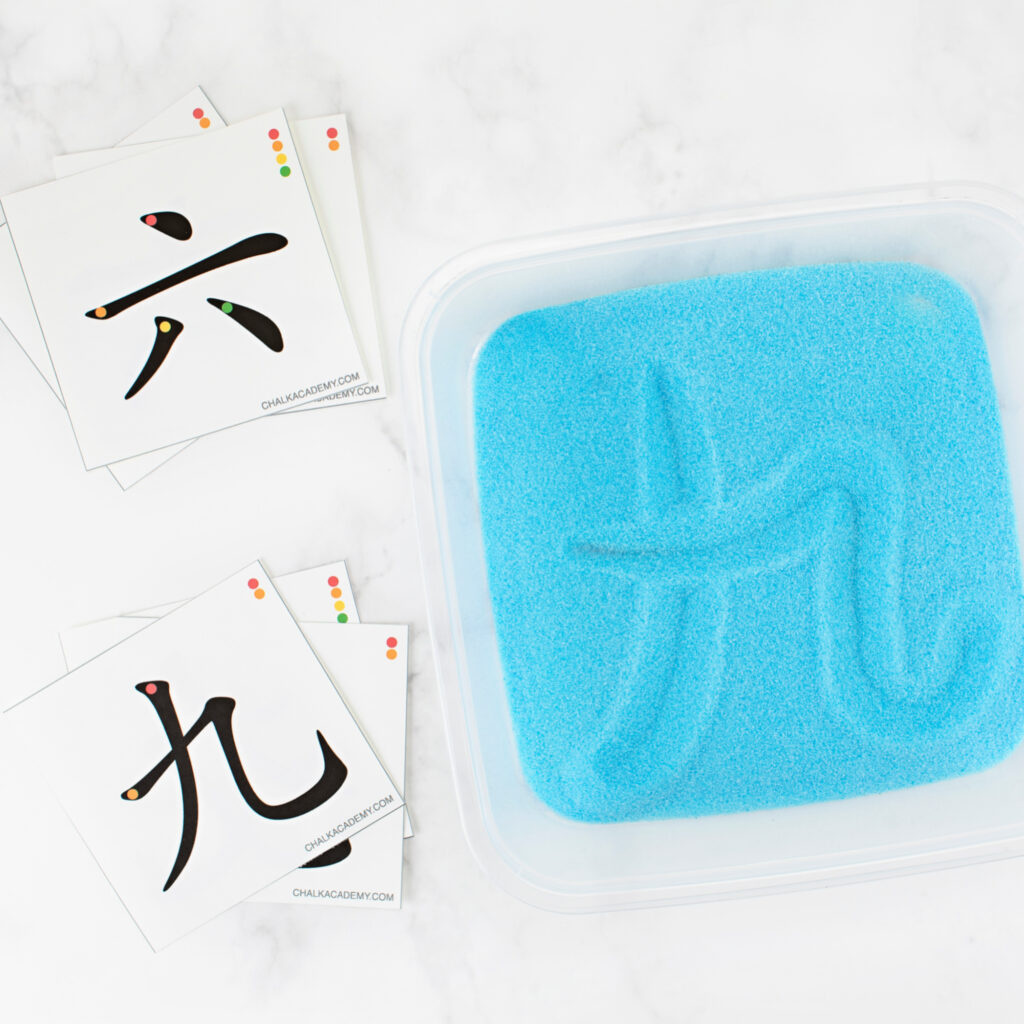
Baking soda writing with wood tray
The next example was from our Chinese 木 Radical Words – Wood Dice and Sensory Writing Game. In hindsight, baking soda was a bit messy, and we much prefer salt.

Rice writing with baking dish
Here’s an example of writing Korean letters in expired rice paired with puffy paint tactile flashcards. I put a black sheet of paper under our glass dish to give contrast against the rice.
My kids actually have not done this with Korean – I set this up for my daughter, but she was already comfortable with writing at that time.

However, we found that writing in salt and sand is more accurate than larger grains like rice or even sprinkles.
In any case, it’s fun to explore writing in different textures!
Montessori sensory salt writing tray videos
Here’s a video of how to set up the sensory writing tray and use the Chinese stroke order flashcards.
In the next video, I kept the normal sound and speed so you can see how all senses are engaged in this writing exercise!
Did you hear the satisfying crunch sound with each stroke?! Also notice how it takes my daughter a few cards to get into the rhythm! This was her first time writing in a sensory tray. However, after a few times, writing improves and children will notice adjust the length of each stroke.
What if my child throws the salt or sand?
Before starting any activity, I set clear rules with my kids about what they can and cannot do. Although my kids have not thrown the Montessori salt trays, they do need gentle but firm reminders not to throw sand at the beach.
If your child is not able to listen, tell them that you need to remove the tray. Let your child know that another chance can be considered in the future if they can follow the rules.
Have you tried Montessori salt writing trays with your child?
I hope your child has as much fun learning how to write as my children! As Aristotle once said, “There is nothing in the intellect which is not first in the senses.”
If you try this activity, please let us know in the comments below! What age(s) are your kid(s), and how did it go? We’d love to hear about your learning experience!
Teach kids how to read Chinese
- 15 Ways to Encourage Your Child to Read
- Create a Print-Rich Environment with Labels that Promote Literacy
- How I Taught My Child 1000+ Chinese Characters as a Non-Fluent Speaker
- 5 Ways My Child and I Are Learning Mandarin Chinese from Audiobooks
- When Should My Child Learn Hanyu Pinyin?
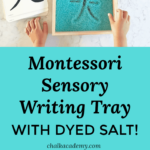
This is awesome Betty, I can’t wait to try it with my kiddos!